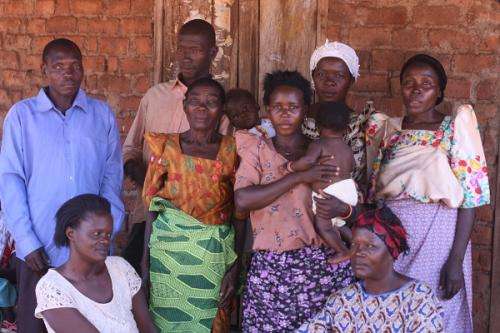Using technology to decrease the knowledge gap between Ugandan men and women

If an in-the-flesh Extension specialist isn't available to provide training, is a video of the specialist's presentation or a video of a new agricultural practice a good substitute? The answer, according to a University of Illinois study with farmers in rural Uganda, isn't simple, particularly when gender is factored into the equation.
"The literature in the field says communication materials like videos work best to support face-to-face communication," said U of I agricultural communications professor Lulu Rodriguez. "But if you don't have an Extension specialist available in a certain locale, a video is the next best thing. The two modes of presenting information work well, particularly for African women learners. It follows the African penchant for having a live presenter, someone to talk to, and their affinity for visuals. Those are important components to how they learn. If situations get dire, a video is a viable option, particularly if there is a live facilitator."
This study explored the effectiveness of three training methods: traditional lecture-field demonstration; lecture and field demonstration plus video; and video only. A video about row bean planting was shown to groups of farmers in Kamuli District, Uganda.
Because the study was trying to uncover gender knowledge gap issues, the groups that viewed the videos were all mixed men and women. The study found that the method that combined video and lecture-demonstration was significantly more effective in narrowing the gender knowledge gap. Watching video alone improved women's knowledge scores but did not close the gap between them and their male counterparts.
"We noticed that whenever we put men and women together in a training session, the women are less likely to speak up. Men often co-opt the discussions," Rodriguez said. "The women will sit back and listen and absorb what they can. This suggests that if a video could be shown to women in a setting that doesn't require interaction with men, they would likely benefit more."
Interestingly, in terms of actual farming, Rodriguez said that women more often have the extra cash needed to implement a new innovation, and they make the decisions about what percentage of the household income will be applied to it. "Unfortunately, women's contributions are not very well acknowledged," she said.
Rodriguez explained that in Uganda, 70 to 80 percent of the agricultural labor force is women, but they don't typically have the access to resources and training opportunities that men have.
"If you want people to be aware of something, research says to use the mass media," Rodriguez said. "But if you really want people to move toward adopting an innovation, such as row planting, it's really the interpersonal communication that will make a difference. The personal touch pushed them toward adopting the practice."
Rodriguez said their study selected the video on how to plant beans in rows because it is needed to beef up the protein content of the Ugandan diet. And because the videos on row planting were already produced, it provided another opportunity to use them and in more remote locations.
"There is a dearth of extension people all over the world, so if we can get these videos distributed to villages and associations, such as farming cooperatives and informal gathering places, viewers can learn a lot by themselves," Rodriguez said. The videos used in the study featured actual Ugandan farmers who demonstrated the row method of planting beans. "People loved seeing themselves and their neighbors being interviewed."
Rodriguez would like to do more in this area—testing the use of communication technologies that might make training easier. She noted that Scientific Animations Without Borders (SAWBO) on the UIUC campus is producing high-quality training videos. Rodriguez said she'd like to test how the African audience will respond to animations as opposed to human presenters on videos.
"African society is very personal with a strong oral tradition so a real person telling a story is a style that resonates with them," Rodriguez said. "A cartoon is more impersonal but may be novel enough to get considerable attention."
"The Ability of Training Approaches to Reduce Agricultural Knowledge Gaps between Men and Women in Rural Uganda" was published in an issue of the Journal of International Agricultural and Extension Education. It was written by Tian Cai, Michigan State University; Lulu Rodriguez, University of Illinois; and Eric Abbott, Iowa State University.
Provided by University of Illinois at Urbana-Champaign
















